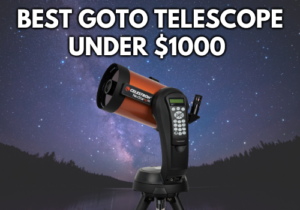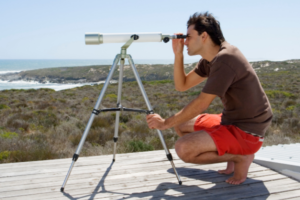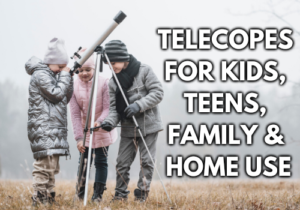Best Telescope Mounts For Astrophotography: Budget & Premium
Disclosure: This post contains affiliate links and I may earn a small commission (at no extra cost to you) if you click through and make a purchase. Thanks in advance – I really appreciate it!
Getting into astronomy is an expensive hobby.
Getting into astrophotography is even more expensive.
Since the mount is what makes or breaks the quality of the image, you’ll want a reliable option that won’t put you into debt, especially if it’s your first, real imaging mount.
Where to start?
We have done the research and here is a list of the 5 best telescope mounts for astrophotography available in the industry that can fulfill all your needs within your price range!
Our Pick
Sky-Watcher EQM-35
- INNOVATIVE MODULAR DESIGN: Customizable design allows for the EQM-35 to be used as a standard EQ mount or as a lightweight tracking platform using a dec bracket (sold separately), making it the perfect grab-and-go telescope mount
- ALL-METAL CONSTRUCTION: Beefy, all-metal construction provides 22-pound payload capacity, perfect for all but the heaviest optical tubes
Prices pulled from the Amazon Product Advertising API on:
Product prices and availability are accurate as of the date/time indicated and are subject to change. Any price and availability information displayed on [relevant Amazon Site(s), as applicable] at the time of purchase will apply to the purchase of this product.
This mount has a very compact design and is portable. You can simply take it wherever you want because it is very portable. It is made up of metal and is durable.
It can bear a weight of 22 pounds. So if your optical device is bulky, all you need is to buy the Sky-Watcher EQM-35.
Mounts We Recommend For Astrophotography
| Image | Title | Price | Buy |
|---|---|---|---|
 | Sky-Watcher EQM-35 | See on Amazon | |
 | Celestron Advanced VX Computerized Mount | See on Amazon |
Product prices and availability are accurate as of the date/time indicated and are subject to change. Any price and availability information displayed on [relevant Amazon Site(s), as applicable] at the time of purchase will apply to the purchase of this product.
Prices pulled from the Amazon Product Advertising API on:Best Telescope Mounts For Astrophotography
1. Sky-Watcher EQM-35
- INNOVATIVE MODULAR DESIGN: Customizable design allows for the EQM-35 to be used as a standard EQ mount or as a lightweight tracking platform using a dec bracket (sold separately), making it the perfect grab-and-go telescope mount
- ALL-METAL CONSTRUCTION: Beefy, all-metal construction provides 22-pound payload capacity, perfect for all but the heaviest optical tubes
Prices pulled from the Amazon Product Advertising API on:
Product prices and availability are accurate as of the date/time indicated and are subject to change. Any price and availability information displayed on [relevant Amazon Site(s), as applicable] at the time of purchase will apply to the purchase of this product.
This mount is computerized and contains a database of more than 42000 celestial objects.
This mount can help you locate desired space objects with great precision. This mount is perfect for both beginners and experts with their efficient optical devices.
The ‘M’ in the mount’s name stands for ‘modular’ because the EQM-35 Pro offers users the option to strip it down into a lighter-weight version, similar to Sky-Watcher’s Star Adventurer mount but with higher capacity and a sturdier platform.
The transition to lightweight photographic mode is made by removing the dec. axis completely from the mount.
EQM-35 Pro is actually an upgraded version of the old EQ3 Pro mount. It is much-improved compared to EQ3 Pro with a large 92.5 mm diameter RA worm wheel, 180 teeth for high precision tracking unlike 130 teeth in the EQ3 Pro, and the strength of the rotary base has been increased.
This upgrade is more stable with fewer vibrations and a more payload capacity of 22 lbs.
The periodic error was also improved. Another advantage is portability.
You can strip it down from the DEC axis motor and heavy counterweight to use it only with the DSLR camera, so the total weight is vastly reduced for travel.
2. Celestron CGX Computerized Equatorial Mount
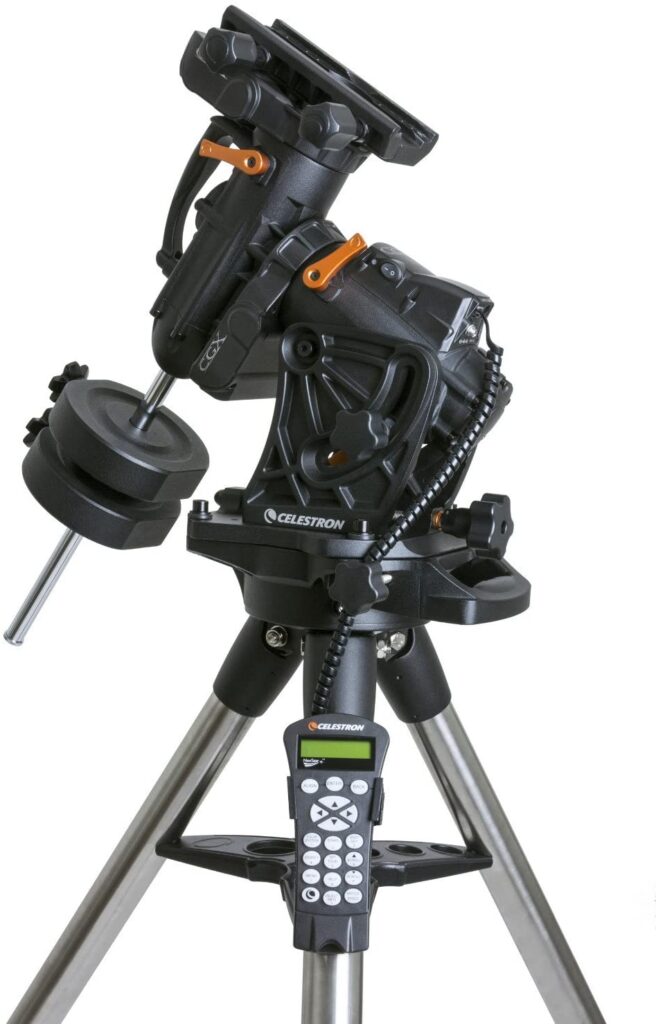
The CGX is one of those mounts that advanced users should buy – that is if they want the best backlash-free performance from a high-quality and highly accurate mount.
It’s perfect for astrophotography use as it has redesigned improvements that allow ultimate, worry-free remote operation.
The Celestron CGX is Celestron’s newest heavy payload computerized equatorial mount and is in a way the successor to the Celestron CGEM Mount.
The CGX has a weight capacity of 55 lbs or 25 kilograms, which is far improved over the EQ6-R or CGEM, being 5 and 7kg more respectively.
This means that you will be able to load the CGX up with far more weight and still have good guiding, however, this number can sometimes be difficult to interpret.
The mount accepts both Vixen (narrow style) and Losmandy (wide style) dovetails, an improvement over the CGEM, which allows you to use any telescope that has a standard mounting system with the CGX, provided you can balance the mount with enough counterweights and keep the weight on the mount under around 25 kilograms.
The CGX also includes a Nexstar+ hand controller. It is the standard hand controller used across all of Celestron’s computerized mounts.
It includes over 40,000 objects with Messier, NGC, IC, and custom coordinates for finding any target in the sky that you choose.
3. Orion AstroView EQ Mount Drive Kit
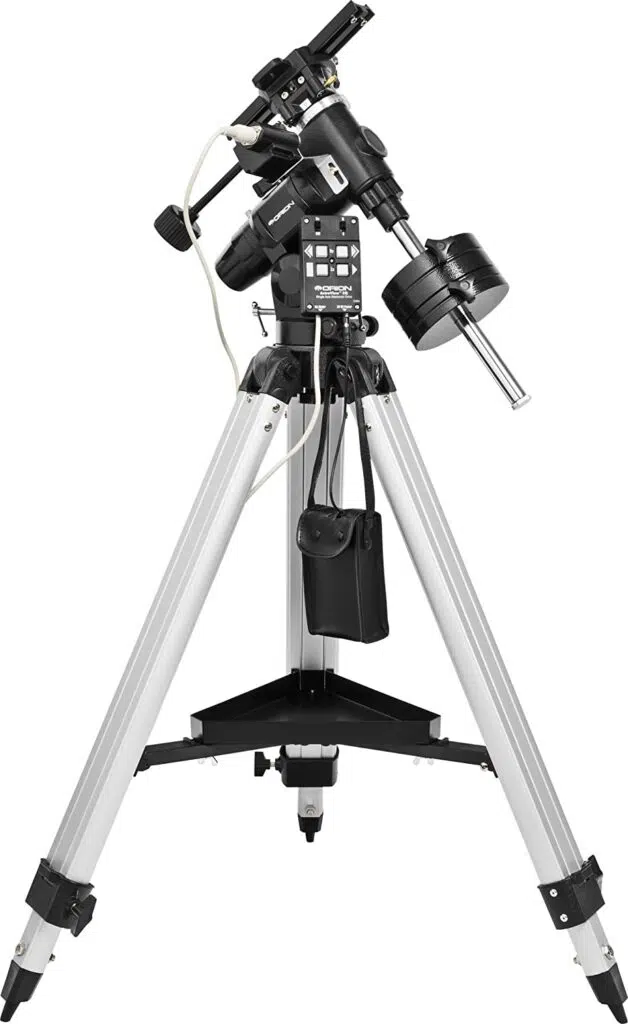
Whether you’re looking to upgrade from your present telescope mount or are seeking a more robust, motorized equatorial system for a new telescope, you can’t go wrong with the smooth-moving, sturdy Orion AstroView EQ & EQ-3M Motor Drive Kit.
The AstroView Equatorial (EQ) Mount head has a convenient dovetail attachment saddle that makes it easy to attach telescopes or swap between more than one telescope without having to hassle with tools.
An 8″ long dovetail attachment plate is included in case your telescope isn’t equipped with one.
The AstroView Mount can support telescopes weighing up to 12 pounds and has enclosed worm gears, an azimuth adjustment, and dual manual slow-motion controls.
A hinged center brace adds stability to the adjustable aluminum tripod, and a high-walled accessory tray makes for a great storage spot for eyepieces, Barlow lenses, filters, and more while you’re stargazing.
The included polar alignment scope makes aligning the Right Ascension (R.A.) axis on Polaris nice and easy for delightfully accurate tracking performance.
A 7.5 lb. and 4 lb. counterweight are also included.
4. Celestron Advanced VX Computerized Mount 91519
- Advanced VX Equatorial Head - Tripod - Accessory Tray - 1 x 12 lbs counterweight - NexStar+ Hand Control - DC Power Cable (plugs into cigarette lighter socket) - 2-Year Warranty
- The most compact and portable of Celestrons German equatorial mounts offers the same rigidity as our larger mounts with minimal flexure and an improved industrial design
Prices pulled from the Amazon Product Advertising API on:
Product prices and availability are accurate as of the date/time indicated and are subject to change. Any price and availability information displayed on [relevant Amazon Site(s), as applicable] at the time of purchase will apply to the purchase of this product.
The Advanced VX mount is designed for beginners who want a leg up in the GoTo, GEM, and imaging fields of astronomy.
Intermediates would be able to get some good use out of the AVX, and they’ll certainly find the portability of the mount as an attractive feature.
The Advanced VX is a starter astrophotography mount. It can handle payloads up to 15 lbs for imaging, and this can be done with a reasonable setup.
It has a computerized equatorial system in the form of a motorized, dual-axis motor with encoders, NexStar+ hand control, and multiple ports to plugin for remote control.
Engineered and optimized for astrophotography with mid-sized optical tube assemblies (OTAs), the Celestron Advanced VX GoTo German Equatorial Mount delivers the performance required for clear images through the use of dual-axis low-cog DC servo motors and backlash compensation.
Added to this are encoders on the motors and Permanent Periodic Error Correction (PPEC), which help to improve positioning and tracking precision and ensure your target object stays centered for long-exposure photography techniques.
As such, the AVX is appropriate for its price point as an entry-level imaging mount with an increased payload capacity, beefier tripod legs, and electronic benefits that allow remote control.
All this is provided in a lightweight setup that is worthy of travel.
5. Orion 9055 Min-EQ Tabletop Equatorial Mount
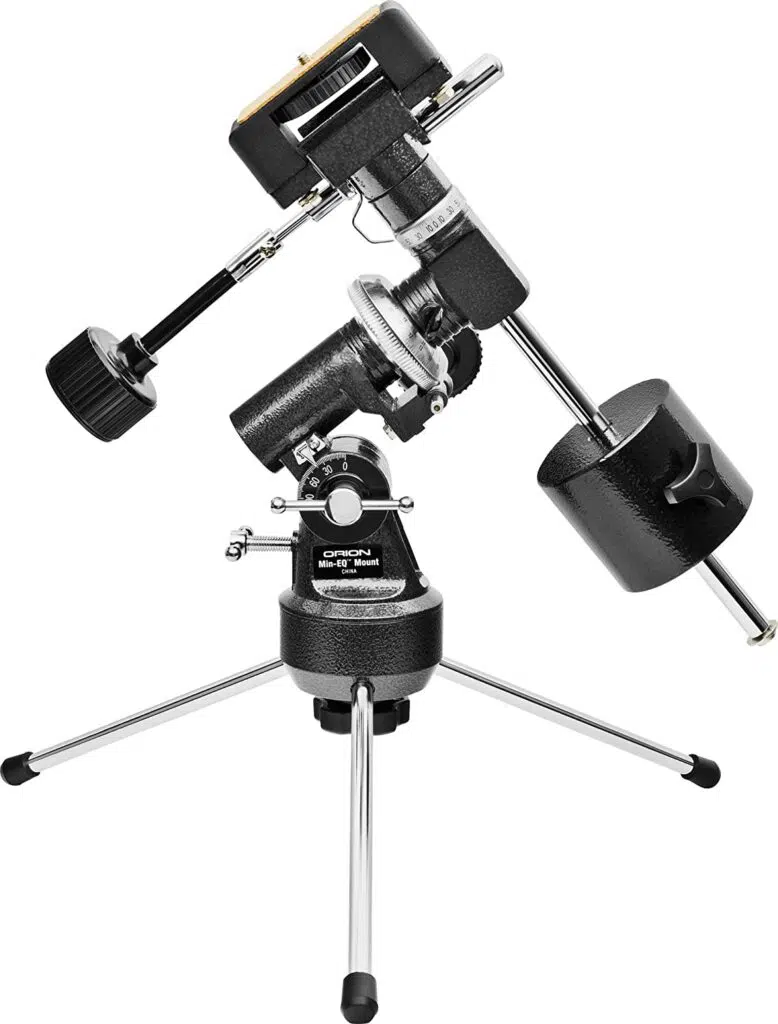
If you are looking for a compact telescope mount that you can keep in your backpack and take along on your camping trips, Orion 9055 Min-EQ Tabletop Equatorial Telescope Mount is just what you are looking for.
In terms of functionality, there isn’t a whole lot to talk about, to be honest. This is a tiny unit that can house no more than 7lbs, yes you didn’t read that wrong, it is only 7lbs.
Despite its simplicity, it’s possible to do some meaningful astrophotography with this mount. The main selling point of this item is obviously the price and its unmatched portability.
Still, it does conduce to some fantastic wide-angle astrophotography with its sturdy EQ-1 mount that supports motor drive and its powerful slow-motion controls.
This mini EQ mount is even great for wide-field astrophotography with a 35mm DSLR camera.
Set it on a picnic table, large rock, or even on the hood of your car for improvised stargazing. With an approximate height of 14″ and weighing just 10.4 lbs, this mount is the perfect size for campouts or when traveling.
What To Look For In A Good Astrophotography Mount
Probably the most important and most expensive piece of the astrophotography setup is the mount. We have two main types of telescope mounts, altazimuth(AZ) and equatorial(EQ). The most commonly used mounts for astrophotography are EQ mounts. AZ and EQ mounts can be motorized or GoTo and manually controlled.
So, for astrophotography, it is essential to have a motorized mount that is tracking the stars automatically so we can do long exposure photos.
Alt-Azimuth Mount
AZ mounts are very common for visual astronomy, but they are not suitable for astrophotography even with tracking. You can, of course, take pictures of the moon and planets but to do long exposure photos you need an EQ mount.
You can do maybe 20-second exposure with AZ mount, but longer exposures will suffer from star trailing because of the field of view rotation.
Although you can point an altazimuth mount at any part of the sky, you are going to have to move it both horizontally and vertically to track.
This will cause the field of view to rotate in the eyepiece as you track the star. Altazimuth mounts can be ideal for casual stargazing but will be too inaccurate for astrophotography.
Equatorial Mount
Equatorial mounts are designed to compensate for the rotation of the Earth and to track the motion of stars and other celestial bodies.
The Earth performs a full rotation every 23 hours, 56 minutes, and 4.09 seconds, but fortunately, most celestial objects you will be observing are so far away that this movement is barely noticeable to the human eye.
When it comes to astrophotography, especially long exposure shots, that movement may leave a motion blur, which will appear as star trails.
Equatorial mounts will use a polar axis, or right ascension axis, which is aligned to the same axis of rotation as the Earth.
Hence, most astrophotography experts prefer using equatorial mounts instead of alt-azimuth mounts.
These mounts come equipped with motorized drives that enable them to account for the earth’s rotation and automatically readjust their positions to find the perfect view of the mobile target object.
Avoid Low-Quality Cheaper Mount
Although the low price of the mount may tempt you, I highly recommend going for a mount from a reputed brand if you’re serious about astrophotography.
There are some inexpensive, flimsy mounts out there that would seem appealing to you because of their low price.
By all means, there are some good budget options up for grabs. But even so, you need to make sure the mount you are buying fulfills certain criteria- otherwise, you would be throwing your money away.
Consider Mount’s Payload Capacity
Most manufacturers brag about their mounts being able to hold more than one telescope at a time; if you chose such mounts, be sure to add the collective weight of your telescope (along with the extra eyepieces) before breaking out your wallet. Most telescopic mounts of medium-range only support the weight range of 30-40 lbs.
If a mount advertises it has a payload capacity of, say, 50lbs, it could either mean it can hold a total of 50lbs, or it could hold a telescope 50lbs of the camera and telescope weight and 50lbs on top of that for the counterweight.
You need to know the specifics, or else you might end up breaking your mount.
Autoguiding Capacity
Autoguiding can help your mount to track the object more precisely for a longer period of time. It is correcting the slight movement imperfections of the mount.
However, it is not necessary if you are only starting with astrophotography, you will be fine with the tracking of the mount alone.
But, it is good to keep this in mind for the next upgrade when you learn the basics. I’m pretty sure you will want to shoot very long exposures for the faint deep sky objects.
Portability
It depends on your circumstances but some will want to be able to easily move the mount and set it up quickly.
Sturdiness
You need a strong mount that will give your telescope the desired stability. You can’t afford the telescope to budge in the wind while you are trying to take a photo of something that is drifting across space.
Look for a heavy and well-built mount to serve this purpose.
USB Connectivity
This allows you to directly connect a laptop or similar device to use to operate the mount rather than just the hand controller. This gives you the freedom to use different software of your choice.
Conclusion
The complications involving astrophotography would have been significantly less if the earth stayed still.
You need to use an equatorial mount that can compensate for the earth’s rotation and help you take pictures of distant space objects with desired quality.
In this article, I’ve only reviewed equatorial mounts because they are always the first choices for astrophotography.
You can get some good photos of the cosmos using alt-azimuth mounts too, but it’s nowhere near as simple as using equatorials.
Written by:

Prakash Chandra
I am a science and technology enthusiast who is curious about emerging concepts in spaceflight, aerospace, and robotics. My passion for astronomy started in my childhood, and my craze for writing started when my works got published in my school's newspaper.
ABOUT US
We are a team of active amateur astronomers, here to help you with all your astronomy and science related needs – this is anything, from reviewing the latest telescopes to be released to talking about gravity and neurons. The Big Bang Optics was started because of our love for astronomy and to help others like us find the best telescope and accessories.
LEGAL DISCLAIMER
The Big Bang Optics is a participant in the Amazon Services LLC Associates Program, an affiliate advertising program designed to provide a means for sites to earn advertising fees by advertising and linking to Amazon.com. The Big Bang Optics also participates in affiliate programs with Clickbank and other sites. The Big Bang Optics is compensated for referring traffic and business to these companies.



